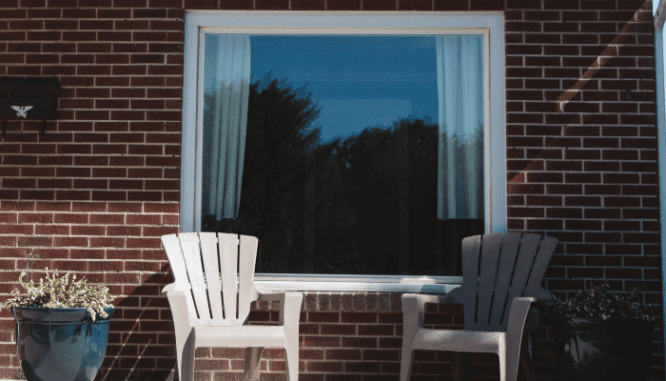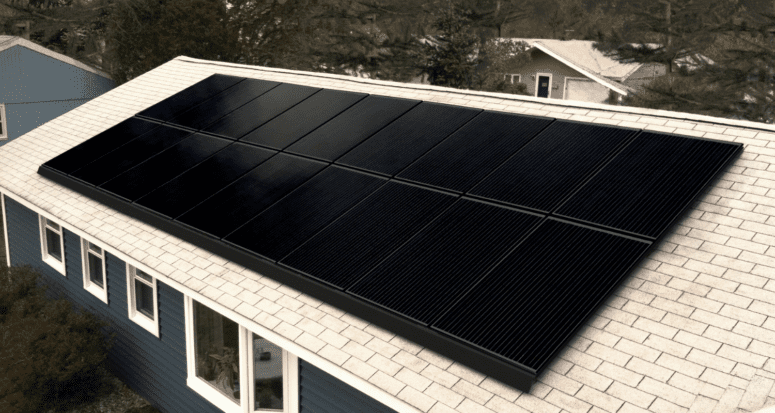Net Zero Homes: Your Guide to the Greenest Housing Option
- Published on
- 8 min read
-
 Allaire Conte Contributing AuthorClose
Allaire Conte Contributing AuthorClose Allaire Conte Contributing Author
Allaire Conte Contributing AuthorAllaire Conte is a writer with a passion for real estate, technology, and nature. She holds her MFA in Nonfiction Writing from Columbia University and is based in Brooklyn.
Buildings account for 40% of all energy consumption in the U.S. annually, with the residential sector accounting for as much as 21% of that figure. For the eco-minded, this is concerning. But what if there was a way for our homes to create as much, if not more, energy than they used every year?
This capability is no longer the stuff of science fiction: Net-zero homes are designed to produce as much energy as they consume. If this building method becomes more accessible, we could solve the residential sustainability crisis.
To get the low down on this exciting new future in home design, we spoke to industry experts and rounded up stats on net-zero home costs and energy savings.

What is a net-zero (NZ) home?
Net-zero (NZ) homes — sometimes referred to as zero-net-energy homes (ZNE) — are houses that produce as much energy as they use by maximizing efficiency and harnessing renewable energy sources. But it’s not as simple as producing the exact amount of energy the home needs each day. Dina Owens, Director of Marketing at Indigo Architects, a firm specializing in LEED-certified and zero-net-energy homes, explains:
“Zero-net-energy means that over the course of a year, a house generates as much power as it uses. The ‘net’ means that it is not necessarily operating at zero energy each month. Generally, in the winter, the house will use more energy than it generates, but in the summer, it will generate more energy than it uses, usually by the addition of solar panels. Hence, the ‘net’ energy use for the year is zero.”
Compare this to a traditional home, which relies on utilities like gas and electricity for power without ever producing any of its own energy. Not only does this hurt the environment by contributing to greenhouse gas emissions, but it can take a toll on your wallet. The average single-family household spends $2,060 a year on energy bills alone.
Where did the idea come from?
The origin of net-zero buildings can be traced back to the turn of the millennium at Oberlin College. In the groundbreaking speech for the now nationally recognized Adam Joseph Lewis Center for Environmental Studies, the center’s inaugural director, David Orr, asked:
“Is it possible to design buildings so well and so carefully that they do not cast a long ecological shadow over the future that our students will inherit? We now know that such things are possible – that buildings can be designed to give more than they take.”
What was so revolutionary about Orr’s concept was that homes didn’t need to stop consuming energy entirely, but rather, they needed to do so more efficiently while generating energy to offset that consumption.
Over the next two decades, advances in insulation, energy-efficient appliances, and government incentives for green building made Orr’s idea of a building that creates more energy than it consumes became not only possible but attainable. The New Buildings Institute (NBI), an organization that promotes energy efficiency and tracks net-zero buildings, has found a 700% increase in verified net-zero buildings in the United States and Canada since they first started tracking them in 2012.

Elements of net-zero home
Net-zero homes come in many different shapes and sizes but share the following characteristics:
Solar power
While the ultimate goal of net-zero home design is to minimize energy use, homeowners will still need to use some energy. That’s where the renewable powerhouse of solar energy comes in. This sustainable power source provides all the energy needs for net-zero homes by harnessing the power of the sun. But it’s not just as simple as slapping a few solar panels on your roof. Solar power provides two major functions for net-zero homes:
Solar tempering
Through the process called solar tempering – sometimes referred to as sun tempering – homeowners can maximize incidental thermal energy from the sun. In simpler terms, homeowners can use the sun to heat and light their homes without additional technology by orienting a home to the earth’s rotation.
While solar tempering likely can’t provide all of the home’s heating and lighting needs, it can provide as much as 20% to 30% of a home’s total heating requirements.
Because of the highly specialized nature of solar tempering, homeowners will need to enlist the help of an industry expert who can orient the home and recommend the correct superinsulation and ventilation. These design considerations can add up to 5% to 8% to the total cost of the house.
Solar electricity
Solar panels are a primary way net-zero homes produce as much energy as they consume. By converting the sun’s energy into electricity, net-zero homes can create the electricity they need and sometimes even more.
For maximum effectivity, solar panel professionals orient the panels to face the sun during the hours when its radiation is strongest — usually, 11 am to 4 pm.
The amount of energy solar panels can produce varies depending on region, orientation, and weather. Still, you can expect significant returns on this renewable asset regardless of your home’s location. The National Renewable Energy Laboratory estimates that home value increases $20 for every $1 reduction in annual utility bills.
Efficient insulation
Adequate insulation is important in any home. The EPA estimates that proper insulation can save the average homeowner 15% on heating and cooling costs by more effectively regulating a home’s temperatures — and it is precisely this energy-saving ability that makes insulation especially important for net-zero homes.
Climate-appropriate insulation can reduce energy consumption from HVAC systems by keeping the home warm in cold months and cool in warm months. To ensure that you get the proper insulation for your climate, check out the Department of Energy’s useful guide on R-Values — or the resistance to conductive heat — for the continental U.S. A general rule of thumb is that the colder the climate, the higher the R-Value is needed.
Net-zero homes take insulation to the next level by creating a super envelope of climate control. This means insulating not just the walls and the attics like in most traditional homes, but also insulating the floors and ceilings. These extra layers of insulation help further regulate the home’s temperatures and keep energy consumption low. Many net-zero architects even go so far as to factor insulation needs into their design by incorporating advanced framing techniques, which factor in additional space into the home’s blueprints for superinsulation.
Carbon offset
The United Nations Environment Program found that buildings and construction account for 39% of total carbon emissions annually. While net-zero homes go a long way to reducing the amount of energy (and associated carbon emissions) a home consumes, there are still emissions associated with the materials in the home, the process of building the house itself, and even in maintaining it.
So in order for a net-zero home to truly be net-zero, it needs to offset emissions by taking in as much or more carbon as it is responsible for creating. There are two ways to do so:
Carbon Sequestration
If you recall from biology class, during photosynthesis, plants take carbon dioxide from the atmosphere and flush it into the soil, producing oxygen as a byproduct. When done en masse, as happens in a forest, this process produces a carbon sink effect: Together, the plants filter tons of carbon out of the atmosphere and store it safely underground. This process is called carbon sequestration.
While forests and our oceans are currently the most efficient at sequestering carbon, scientists are developing other materials, like eco-friendly cements and plastics capable of carbon sequestration. Until then, net-zero home builders can bake carbon sequestration into their home design by prioritizing wood — which is, on average, 50% carbon by weight — and by planting carbon-guzzling trees like maple and poplars (so long as they are native to the area).
Purchasing carbon credits
Not everyone can plant enough maples and poplars to offset their emissions, though, which is where carbon credits come in. Homeowners can purchase these credits from brokers who then funnel the money to carbon sequestering projects around the world. For instance, credits could go towards an environmental group’s rainforest restoration project or to a company producing highly efficient wind turbines.
Though this sounds abstract, these credits act as a global accounting tool to balance emissions. So even if the wind turbine your credit helped fund is half a world away from your dream net-zero home, it’s still offsetting the carbon that your home is responsible for emitting from a global perspective.
Homeowners can choose between buying credits as a one-time purchase or as a monthly or annual subscription. You even have the option to select which eco-projects you’d like to support around the world. If you’re eager to get started, certified B Corp and public benefit company, NativeEnergy, is widely regarded as a leader in carbon credits.

Energy savings with a net-zero home
In an effort to quantify the savings of net-zero homes, the National Institute of Standards and Technology, a branch of the U.S. Department of Commerce, built the Net-Zero Energy Residential Test Facility (NZERTF). This two-story, four-bedroom, three-bath net-zero home served as a laboratory for researchers to emulate the living patterns of a four-person family over two years.
The study found that the NZERTF was 74% more efficient than similarly sized single-family houses and produced an excess of 2,138 kilowatt-hours. In other words, not only did the net-zero home use less energy overall, but it also produced more energy than it used — about one-fifth of the total kilowatt-hours of electricity the average home uses every year.
The results of the NZERTF underline the staggering amount of energy conservation that net-zero design can achieve — conservation which translates into considerable savings for homeowners. As a part of similar research initiatives to the NZERTF, California commissioners estimate the savings of a net-zero home to be about $19,000 over 30 years.
So you want a net-zero home? Weigh your options
The cost of a net-zero home can be as much as 5% to 10% more than a comparable standard home; however, as noted above, the savings are substantial. Whether you want to start from scratch or give your current home a carbon-neutral makeover, working with certified experts is the way to go because of the highly specialized nature of these buildings.
Retrofitting your home is feasible yet expensive
In a 2017 study, the Rocky Mountain Institute (RMI) — a nonpartisan, nonprofit organization dedicated to accelerating the green energy transition — named desirability, convenience, and cost as the three biggest barriers to retrofitting existing homes into net-zero buildings.
Since then, the desirability of green homes has skyrocketed, but convenience and cost continue to be blockers for eco-minded homeowners dedicated to living carbon neutral.
The inconvenience factor cannot be overstated — retrofitting an existing property into a net-zero home is an elaborate process. Homeowners need to seek out specialists capable of evaluating the home’s existing water, heating and cooling, lighting, appliance, and insulation needs. These experts must evaluate the home’s solar capabilities and determine if the home can produce as much energy as it uses.
Consequently, it takes vast amounts of highly specialized (and expensive) labor to determine if net-zero is achievable for the building, let alone execute the retrofitting. The high price of specialized labor, building materials, and features presents the second barrier to retrofitting a home: high cost. Given the unpopularity of this option, there is little data on conclusive averages of the cost of retrofitting homes. However, our research indicates that the process would fall safely in the six-figure range for most residential properties.
Owens emphasizes the complexity of deciding whether or not to retrofit or start net zero from scratch:
“Reusing an existing home is always going to be more sustainable and environmentally friendly. However, making an outdated energy-inefficient home into a zero-net energy home is extremely challenging … It is very difficult to reorient an existing home on a property without near-complete demolition.”
A prefabricated net-zero home is the simplest option
The most cost-effective option for a net-zero home is to work with a prefabricated builder. These homes are manufactured in a factory, then shipped and assembled on site. Because the buildings are designed with a template and are assembled on demand, they create less waste, have shorter construction times, and generally cost less overall than traditionally built net-zero homes.
BrightBuilt Home, a design firm that specializes in prefabricated net-zero homes, offers models from $175 to $180 per square foot. Unlike other prefabricated homes, net-zero prefabs bake in some customization into each design to maximize every site’s unique energy assets and needs.
A custom net-zero home is more affordable than you’d expect
If the idea of constructing the net-zero home of your dreams is too enticing to pass up, you may be in luck: In another nationwide study, RMI found that the cost to custom build a net-zero home was far less than previously thought. Their findings estimate that net-zero-energy homes cost 6% to 8% more to build than a traditional house.
The higher cost is due to the lack of builders capable of designing these specialized buildings, which make up less than 2% of new construction nationally. As the demand for zero-net-energy homes increases and more builders specialize in net-zero design, the price of the construction will decline.
Owens underlines this fact: “The advantages of custom building a zero net energy home cannot be overstated. If correctly done, a zero-net-energy home can be designed at no additional cost as compared to traditional building. Most of what contributes to making a home zero net energy goes into the initial design; it makes much more sense to make a home zero net energy if you are designing custom and building new.”
ROI: Net-zero homes recoup their build cost over time
If you can front the costs of a net-zero home, though, the return on investment may be worth it. Consider this: According to the National Association of Home Builders, the average cost to build a home is $241,000, as compared to $263,500 for a net-zero home. If you factor in the $19,000 savings on energy costs over 30 years, net-zero homes come close to paying the difference.

Selling a net-zero home
If you decide to trade your net-zero home in for an Earthship or net-zero tiny house, take care to market your home effectively so you can capitalize on the growing demand for green homes.
The most crucial step to selling a net-zero home is to get your home certified. A net-zero energy home certification clearly designates your home as the real deal, not as a greenwashed knockoff. Not only will it be a selling point for eco-minded buyers, but it will help support the higher asking price for your uniquely sustainable home.
There are two nationally recognized energy ratings: the HERS rating system and the Energy Performance Score (EPS). The HERS system will evaluate your home’s energy efficiency against a reference home of equal size and shape. The lower your score, the more efficient your home; but for your home to be truly net zero, you’ll need to aim for a perfect score of zero. Likewise, EPS measures your home’s energy consumption on a scale of zero to 200, so net-zero homeowners should secure a score as close to zero as possible.
Environmental change starts at home
Still on the fence about making the switch? Daniel Poynter, the founder of Carbon Neutral Indiana, a grassroots organization to reduce the carbon footprint of Indiana, makes a case for the net-zero way of life:
“Going carbon neutral takes responsibility for personal emissions and takes leadership in the initiative that encourages others to do so, as well. The world needs to be carbon neutral by 2050, but we don’t need to wait. Parts of the world can achieve it today. First, small parts like households and businesses. Then, larger, and larger parts like cities, states, and countries.”
If you’re ready to explore your net-zero home options, browse the Department of Energy’s database of eco-expert builders to consult trusted net-zero home professionals.
Header Image Source: (Vivint Solar / Unsplash)
